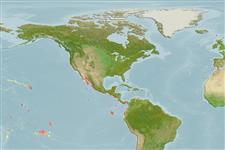>
Gobiiformes (Gobies) >
Microdesmidae (Wormfishes) > Ptereleotrinae
Etymology: Ptereleotris: Greek, pteron = wing, fin + The name of a Nile fish, eleotris (Ref. 45335); carinata: Name from Latin 'carina' for keel, 'carinata' meaning keeled; referring to the distinct membranous keel extending beneath the head..
Environment: milieu / climate zone / depth range / distribution range
นิเวศวิทยา
เกี่ยวกับทะเล,น้ำเค็ม สัตว์น้ำหน้าดิน; ระดับความลึก 12 - 25 m (Ref. 75966). Tropical
Eastern Pacific: Mexico (Gulf of California), Costa Rica and Panama.
ขนาด / น้ำหนัก / Age
Maturity: Lm ? range ? - ? cm
Max length : 8.3 cm SL เพศผู้/กระเทย; (Ref. 75996)
Short description
สัณฐานวิทยา | ความยาวต่างๆ
เงี่ยงครีบหลัง (รวม): 7; ก้านครีบอ่อนที่หาง (รวม): 20-22; เงี่ยงครีบก้น 1; ก้านครีบอ่อนที่ก้น: 20 - 23. This species is distinguished from its congeners by the following characters: a short dorsal-fin (VI-I,20-22), first and second dorsal fins of about equal height; short anal-fin (I,19-22);isthmus with a conspicuous median fold or keel; caudal fin lanceolate with a dusky band on lower caudal rays in adults; a blue or lavender body without other markings (Ref. 75966).
The western Atlantic form, Ptereleotris calliurus, is similar to P. carinata in its more lanceolate tail with dark lower half, but differs from P. carinata in having a variety of other fin markings (vs. absent).
Individuals were seen poised 10-20 cm above small mounds encircling the small openings to their burrows. It was also observed in burrows always close to a reef or grouped in small colonies on gently sloping mud-sand bottoms usually hundreds of meters from any rocky substrata. Juveniles were collected with quinaldine from the same burrows as adults they darted into. Often two adults or an adult and one or two juveniles were seen to occupy the same burrow. Individuals when prevented from entering their own burrow, would sometimes swim away rather than enter neighboring burrows (Ref. 75966).
Life cycle and mating behavior
วัยเจริญพันธุ์ | การสืบพันธุ์ | การวางไข่ | เซลสืบพันธ์ของเพศเมีย(ไข่) | ความดกของไข่ | ตัวอ่อน
Bussing, W.A., 2001. Ptereleotris carinata, a new species of hovering goby (Perciformes: Microdesmidae) from the tropical eastern Pacific. Rev. Biol. Trop. 49(Supl. 1):133-139,. (Ref. 75996)
IUCN Red List Status (Ref. 130435)
Threat to humans
Harmless
Human uses
ข้อมูลเพิ่มเติม
ชื่อสามัญชื่อพ้องกลไกการเผาผลาญพลังงานผู้ล่าการศึกษาเกี่ยวกับผลกระทบของสารประกอบทางเคมีที่เป็นอันตรายต่อสิ่งมีชีวิต ประชากร และสิ่งแวดล้อมการสืบพันธุ์วัยเจริญพันธุ์การวางไข่การรวมกลุ่มวางไข่ความดกของไข่เซลสืบพันธ์ของเพศเมีย(ไข่)Egg development
Age/SizeการเจริญเติบโตLength-weightLength-lengthLength-frequenciesความยาวต่างๆสัณฐานวิทยาตัวอ่อนพลวัตของสัตว์น้ำวัยอ่อนการทดแทนที่อุดมสมบรูณ์BRUVS
อ้างอิงการเพาะเลี้ยงสัตว์น้ำประวัติการเพาะเลี้ยงสัตว์น้ำสายพันธุ์พันธุศาสตร์ElectrophoresesอัตราพันธุกรรมโรคการแปรรูปNutrientsMass conversion
ผู้ร่วมมือรูปภาพหลายรูปStamps, Coins Misc.เสียงปลามีพิษ เช่น ปลาปักเป้าความเร็วรูปแบบการว่ายน้ำพื้นที่เหงือกOtolithsสมองวิสัยทัศน์
เครื่องมือ
Special reports
Download XML
แหล่งที่มาจากอินเตอร์เน็ต
Estimates based on models
Preferred temperature (Ref.
123201): 24.2 - 29.1, mean 27.9 °C (based on 109 cells).
Phylogenetic diversity index (Ref.
82804): PD
50 = 0.5000 [Uniqueness, from 0.5 = low to 2.0 = high].
Bayesian length-weight: a=0.00389 (0.00180 - 0.00842), b=3.12 (2.94 - 3.30), in cm total length, based on all LWR estimates for this body shape (Ref.
93245).
ระดับชั้นอาหาร (Ref.
69278): 3.3 ±0.4 se; based on size and trophs of closest relatives
Fishing Vulnerability (Ref.
59153): Low vulnerability (10 of 100).
